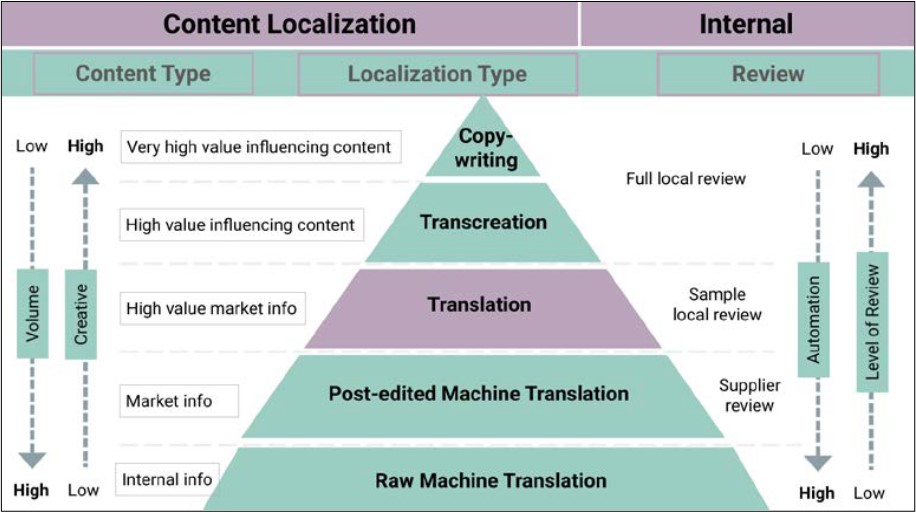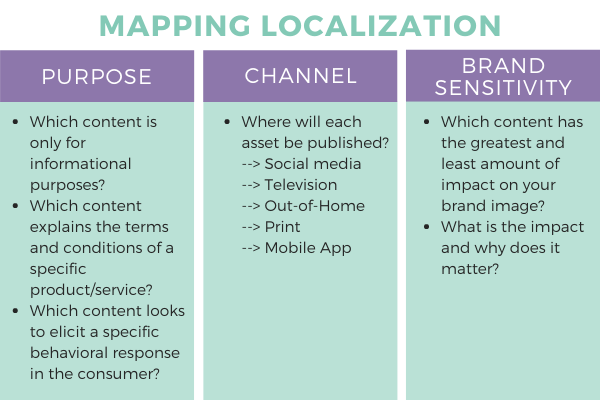Transcreation: Content Profiling and Creativity in Marketing Campaigns

In Netflix’s documentary, The Toys That Made Us, storytellers chronicle some of the most “iconic toy franchises” in history. Including the early 90s live-action series, The Mighty Morphin Power Rangers. Adapted from the Japanese TV series Super Sentai, the show quickly became popular among American youth, fueled by intergalactic action figures and clever merchandising. But how did a show, whose fight scenes were primarily piped in from the original series, become a pop culture icon still in rotation almost thirty years later?
Transcreation.
In this post, we discuss the fundamentals of transcreation, including differences with translation, and provide a useful framework marketers can use to determine when to write, translate or transcreate content.
Understanding Transcreation
Transcreation can be defined “…as a translation that is enhanced by creativity and focuses on style, register, and emotive impact, and is modified to suit a new audience which can be a group of users, a country, a region, etc.”[i]
When Japanese toy manufacturers and advertising agencies saw that traditional word-per-word translation wasn’t driving overseas sales, they shifted their focus to extracting “cultural elements” from their target markets. These cultural elements were instrumental in creating relevant American marketing messages. These tactics later became the building blocks of modern transcreation.
In transcreation, sociolinguistics, or language usage in specific regions or groups as opposed to how language is used universally, is essential.
The translator (transcreator) acts as a catalyst in this process, who subjectively understands the target audience’s cultural environment. The transcreator uses this information to strategically create a unique brand/consumer narrative that looks to elicit a specific behavior.
Translation vs. Transcreation
Paul Mangell, a Western and Asian markets localization expert, wrote in his TAUS’s Transcreation Best Practices and Guidelines foreword that “all good translation is in some way creative – and must take into account the writer and their purpose, plus the reader and their culture.” (pp. 5).
Then why the division between translation and transcreation? Let’s look for clues in history:
In the 17th century, the English poet and translator John Dryden outlined three ways of translating:
- metaphrasing (word-per-word rendition)
- paraphrasing (restatement of the original text)
- imitation (construction of a new message preserving core elements from the original text).
We can state that translation orbits around metaphrasing and paraphrasing. Transcreation has a more substantial relation to Dryden’s imitation concept.
Today’s time-to-market philosophy and its focus on volumes and production output tend to favor translation. This is aided by recent technological advancements (machine translation) that take metaphrasing and paraphrasing more closely to a human-like level.
However, these newer technologies cannot (yet) produce nuanced cultural messages. Nor can they understand the deep interconnection between language and culture. In the same way that a word-per-word rendition cannot influence consumer behavior. Thus, transcreation comes up as the best strategy for multicultural marketers.
Now that we have explained the basics of transcreation and how it differs from translation, let’s discuss how marketers use it to achieve marketing objectives?
The Content Profiling Pyramid: A Decision-Making Tool for Marketers
In 2019, TAUS published the Content Profiling Pyramid as part of their transcreation best practices’ guidelines. This tool is designed to help marketers determine what type of content should be translated or transcreated, and why.

The “Localization Type” section in the middle of the pyramid describes different “tiers” of text-based content. These sections descend from copywriting (the most labor-intensive) at the top of the pyramid, to raw machine translation (completely automated) at the bottom.
Content that ranks higher in the pyramid is considered to have a high influence on the target consumer. This type of content has greater brand impact. Content that is part of an ad campaign, for example, would be considered “high value influencing content” because of its intent to trigger a purchase. On the other hand, content that is part of a technical guide (i.e., instructions for setting up a new smartphone) would be considered “low value influencing content”. Compared to an ad campaign, text from a technical guide could be automated using machine translation coupled with human editing.
To help you map each of your content assets to a specific localization type, consider the following:

A successful content framework will typically combine automated, human, and hybrid content rendering approaches. This combination is to save money and distribute workload among disparate stakeholders.
At the end of the day, utilizing a content framework like The Content Profile Pyramid can help marketers create targeted multicultural marketing campaigns that yield the intended ROI.
Conclusion
Transcreation goes beyond word-for-word translation and can help marketers build deeper connections with multicultural audiences that build on cultural values. Contemporary “time-to-market” mindsets often push marketers to sacrifice cultural relevancy to boost output.
As a result, text content is pushed towards traditional translation. But carefully considering the purpose and impact of your content can guide marketers in choosing the right automated, human, or hybrid content mix to maximize results.
_
Content written in partnership with The Translation Team
[1] Mangell, Paul, Alvaro Merelo Villalvilla, Angela Petrilli, Makiko Aoki, and Vladimir Zhdanov. “TAUS Transcreation Best Practices and Guidelines.” TAUS Signature Editions, May 2019.



![How To Create Effective Infographics [Infographic]](https://crayonsandmarketers.com/wp-content/uploads/2019/08/INFOGRAPHICS-1-768x341.png)


